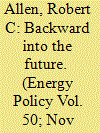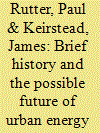|
|
|
Sort Order |
|
|
|
Items / Page
|
|
|
|
|
|
|
| Srl | Item |
| 1 |
ID:
116703


|
|
|
|
|
| Publication |
2012.
|
| Summary/Abstract |
A projection of future energy consumption is a vital input to many analyses of economic, energy, and environmental policies. We provide a benchmark projection which can be used to evaluate any other projection. Specifically, we base our projection of future energy consumption on its historical trend, which can be identified by an experience model. We compare our projection with forecasts by the U.S. Energy Information Administration (EIA) for eight countries-U.S., China, India, Brazil, Japan, South Korea, Canada, and Mexico. We find that the EIA's projections are lower than ours in the case of China, the U.S., India, Japan, and Mexico. This indicates that for these five countries, the EIA uses assumptions which cannot be rationalized by historical data.
|
|
|
|
|
|
|
|
|
|
|
|
|
|
|
|
| 2 |
ID:
116737


|
|
|
|
|
| Publication |
2012.
|
| Summary/Abstract |
It is well known that poor rural households in low-income economies are reliant on traditional fuels to meet basic domestic energy needs, but little is known about the specific underlying socio-economic drivers of residential fuel choices in Ethiopia. I used the linear approximation almost ideal demand system (LAAIDS) with normalized prices to compute expenditure elasticity and a multinomial logit model (MLM) to examine household fuel use. The LAAIDS model result showed that expenditure was elastic for modern fuels, but inelastic for traditional fuels. Regression results from the MLM indicated that fuel choice behaviour of rural households could be more accurately described as 'fuel stacking' behaviour as opposed to the 'energy ladder' hypothesis. In rural areas household fuel choice may be constrained by limited access to commercial fuels and efficient cook stoves, supply dependency and affordability, consumer preferences and a web of other intricate factors. Rural households had less incentive for fuel switching due to underlying factors and the availability of fuel wood without direct financial cost. With continued deforestation and receding forests, households are expected to develop inter fuel substitution and switching behaviour conditional on access to modern energy technologies.
|
|
|
|
|
|
|
|
|
|
|
|
|
|
|
|
| 3 |
ID:
116690


|
|
|
|
|
| Publication |
2012.
|
| Summary/Abstract |
This history of the transition from organic to mineral fuels suggests a number of conclusions that may have parallels in the future: People respond to price incentives; science is important but not sufficient; human capital is important; cooperation is as important as competition; path breaking technologies take a long time to mature.
The future, however, will not - and should not! - be a replay of the past. One of the greatest differences is the externality issues raised by global warming. The choice of fuels and technologies has ramifications far beyond the profit and loss statements of the people deciding them. In that case, decentralized decision making will not reach a desirable overall result. Planning and coordination are essential to tackle these problems.
|
|
|
|
|
|
|
|
|
|
|
|
|
|
|
|
| 4 |
ID:
116752


|
|
|
|
|
| Publication |
2012.
|
| Summary/Abstract |
This article studies the capacity of biofuels to reduce motor fuel price fluctuations. For this purpose, we study dependence between crude oil and biodiesel blend prices in Spain. Copula models are used for this purpose. Results suggest that the practice of blending biodiesel with diesel can protect consumers against extreme crude oil price increases.
|
|
|
|
|
|
|
|
|
|
|
|
|
|
|
|
| 5 |
ID:
116765


|
|
|
|
|
| Publication |
2012.
|
| Summary/Abstract |
This communication discusses climate change adaptation efforts underway in Vanuatu. In particular, it uncovers why community-based approaches to adaptation are more likely to bear fruit than ones driven from the top-down at the national level. The authors make this claim based on early evidence that small-scale projects (a) support community ownership over adaptation, (b) provide ongoing technical learning lessons (c) relieve pressure from capacity constraints at national administrative bodies, and (d) expedite implementation by avoiding cumbersome multilateral procedures. The first section discusses its research methods and presents important characteristics of the Vanuatu economy, people and geography. The communication then moves on to discuss Vanuatu's vulnerability to the effects of climate change. It specifically investigates on-going efforts to adapt to natural climatic hazards in Vanuatu. Early evidence and analysis reveals lessons salient for energy and climate policy.
|
|
|
|
|
|
|
|
|
|
|
|
|
|
|
|
| 6 |
ID:
116695


|
|
|
|
|
| Publication |
2012.
|
| Summary/Abstract |
Modern cities depend on energy systems to deliver a range of services such as heating, cooling, lighting, mobility, communications, and so on. This article examines how these urban energy systems came to be, tracing the major transitions from the earliest settlements through to today's fossil-fuelled cities. The underlying theme is "increasing efficiency under constraints" with each transition marked by increasing energy efficiency in service provision, increasing per capita energy use, increasing complexity in the energy system's structure, with innovations driven by a strategic view of the overall system, and accompanied by wider changes in technology and society. In developed countries, the future of urban energy systems is likely to continue many of these trends, with increased efficiency being driven by the constraints of climate change and rising fuel prices. Both supply and demand side technologies are discussed as potential solutions to these issues, with different impacts on the urban environment and its citizens. However in developing countries, rising urban populations and access to basic energy services will drive the next transition.
|
|
|
|
|
|
|
|
|
|
|
|
|
|
|
|
| 7 |
ID:
116716


|
|
|
|
|
| Publication |
2012.
|
| Summary/Abstract |
The current discussion of climate change and energy problems is generally based on the assumption that technical solutions are possible and that the task is essentially to determine the most effective ways. This view relies heavily on the expectation that renewable energy sources can be substituted for fossil fuels. Australia is more favourably situated regarding renewable sources than almost any other country. This discussion attempts to estimate the investment cost that would be involved in deriving Australia's total energy supply from renewable sources. When provision is made for intermittency and plant redundancy it is concluded that the total investment cost is likely to be unaffordable.
|
|
|
|
|
|
|
|
|
|
|
|
|
|
|
|
| 8 |
ID:
116760


|
|
|
|
|
| Publication |
2012.
|
| Summary/Abstract |
In this paper we estimate the willingness to pay for mix of renewable sources of electric power by means of a discrete choice experiment survey conducted in Spain in 2010. Two main categories of power supply attributes are explored: source of renewable power (wind, solar and biomass) and the origin of such power. The findings suggest that most consumers are not willing to pay a premium for increases in the shares of renewable in their electricity mix. For two of the three renewable sources considered (wind and biomass) an increase of the renewable mix would require a discount. Instead, we record positive willing to pay for increases in the share of both solar power and locally generated power. However, preferences for types of renewable (solar and wind) are found to be heterogeneous. By classifying respondents in two groups according to the implied importance of the share of renewable sources in their power mix we identify a market segment consisting of 20% of respondents that could promote renewable energy in the absence of subsidies. This is because such a segment shows willingness to pay higher than the current feed-in tariffs.
|
|
|
|
|
|
|
|
|
|
|
|
|
|
|
|
| 9 |
ID:
116738


|
|
|
|
|
| Publication |
2012.
|
| Summary/Abstract |
We investigate the impact of climate policies on Canada's oil sands industry, the largest of its kind in the world. Deriving petroleum products such as gasoline and diesel from oils sands involves significant amounts of energy, and that contributes to a high level of CO2 emissions. We apply the MIT Emissions Prediction and Policy Analysis (EPPA) model, a computable general equilibrium model of the world economy, augmented to include detail on the oil sands production processes, including the possibility of carbon capture and storage (CCS). We find: (1) without climate policy, annual Canadian bitumen production increases almost 4-fold from 2010 to 2050; (2) with climate policies implemented in developed countries, Canadian bitumen production drops by 32% to 68% from the reference 4-fold increase, depending on the viability of large-scale CCS implementation, and bitumen upgrading capacity moves to the developing countries; (3) with climate policies implemented worldwide, the Canadian bitumen production is significantly reduced even with CCS technology, which lowers CO2 emissions at an added cost. This is mainly because upgrading bitumen abroad is no longer economic with the global climate policies.
|
|
|
|
|
|
|
|
|
|
|
|
|
|
|
|
| 10 |
ID:
116747


|
|
|
|
|
| Publication |
2012.
|
| Summary/Abstract |
Carbon capture and sequestration (CCS) can be an important technology option for China in addressing global climate change and developing clean energy technologies. Promoted by international climate conventions and supported by government research and development programs, an increasing number of CCS pilot and demonstration projects have been launched in China. In this study, we analyze the structure of China's CCS effort from a technological innovation system (TIS) perspective. Within this system, key socio-political components, including institutions, actor-networks, and technology development, are examined to evaluate the state of the innovation system. The study assessed the perceived capacity of seven functional areas of the CCS innovation system through a survey of key CCS actors and stakeholders. The findings suggest that China's CCS innovation system has a strong functional capacity for knowledge and technology development. It is significantly weaker in the innovative functions of knowledge diffusion, market formation, facilitating entrepreneurs and new entrants into the CCS market. Based on the evaluation of China's technological innovation system to develop CCS, the article articulates specific public policies to formulate a more robust innovation system to traverse the "valley of death" from research and development to commercial deployment and accelerate energy innovation in China.
|
|
|
|
|
|
|
|
|
|
|
|
|
|
|
|
| 11 |
ID:
116717


|
|
|
|
|
| Publication |
2012.
|
| Summary/Abstract |
(1) We estimate CO2 implicitly exported via commodities relative to a region's total emissions: We find -15% for the industrialized, 12% for the developing region, and 24% for China. (2) We analyze a Contraction and Convergence climate regime in a CGE model including international capital mobility and technology diffusion: When China does not participate in the regime and instead a carbon tariff is imposed on its exports, it will likely be worse off than when participating. This result does not hold for the developing region in general. Meanwhile, the effect on emissions appears small.
|
|
|
|
|
|
|
|
|
|
|
|
|
|
|
|
| 12 |
ID:
116736


|
|
|
|
|
| Publication |
2012.
|
| Summary/Abstract |
This contribution investigates causal interdependence between energy consumption and economic growth in Liberia and proposes application of a bootstrap methodology. To better reflect causality, employment is incorporated as additional variable. The study demonstrates evidence of distinct bidirectional Granger causality between energy consumption and economic growth. Additionally, the results show that employment in Liberia Granger causes economic growth and apply irrespective of the short-run or long-run. Evidence from a Monte Carlo experiment reveals that the asymptotic Granger causality test suffers size distortion problem for Liberian data, suggesting that the bootstrap technique employed in this study is more appropriate. Given the empirical results, implications are that energy expansion policies like energy subsidy or low energy tariff for instance, would be necessary to cope with demand exerted as a result of economic growth in Liberia. Furthermore, Liberia might have the performance of its employment generation on the economy partly determined by adequate energy. Therefore, it seems fully justified that a quick shift towards energy production based on clean energy sources may significantly slow down economic growth in Liberia. Hence, the government's target to implement a long-term strategy to make Liberia a carbon neutral country, and eventually less carbon dependent by 2050 is understandable.
|
|
|
|
|
|
|
|
|
|
|
|
|
|
|
|
| 13 |
ID:
116761


|
|
|
|
|
| Publication |
2012.
|
| Summary/Abstract |
This paper investigates the dynamic causal relationship between energy consumption and economic growth in Lebanon over the period 1980-2009. Within a bivariate framework, imposed on us due to data limitations, and in an effort to increase the robustness of our results, we employ a variety of causality tests, namely, Hsiao, Toda-Yamamoto, and vector error correction based Granger causality tests. We find strong evidence of a bidirectional relationship both in the short-run and in the long-run, indicating that energy is a limiting factor to economic growth in Lebanon. From a policy perspective, the confirmation of the feedback hypothesis warns against the use of policy instruments geared towards restricting energy consumption, as these may lead to adverse effects on economic growth. Consequently, there is a pressing need to revise the current national energy policy that calls for a 5% energy conservation target. Also, to shield the country from external supply shocks, given its substantial dependence on energy imports, policymakers should emphasize the development of domestic energy resources. Further, the most pertinent implication is that relaxing the present electric capacity shortages should be made a national priority, in view of its potential positive effect on the economy.
|
|
|
|
|
|
|
|
|
|
|
|
|
|
|
|
| 14 |
ID:
116740


|
|
|
|
|
| Publication |
2012.
|
| Summary/Abstract |
This study analyzes China's industrial energy consumption trends from 1996 to 2010 with a focus on the impact of the Top-1000 Enterprises Energy-Saving Program and the Ten Key Energy-Saving Projects. From 1996 to 2010, China's industrial energy consumption increased by 134%, even as the industrial economic energy intensity decreased by 46%. Decomposition analysis shows that the production effect was the dominant cause of the rapid growth in industrial energy consumption, while the efficiency effect was the major factor slowing the growth of industrial energy consumption. The structural effect had a relatively small and fluctuating influence. Analysis shows the strong association of industrial energy consumption with the growth of China's economy and changing energy policies. An assessment of the Top-1000 Enterprises Energy-Saving Program and the Ten Key Energy-Saving Projects indicates that the economic energy intensity of major energy-intensive industrial sub-sectors, as well as the physical energy intensity of major energy-intensive industrial products, decreased significantly during China's 11th Five Year Plan (FYP) period (2006-2010). This study also shows the importance and challenge of realizing structural change toward less energy-intensive activities in China during the 12th FYP period (2011-2015).
|
|
|
|
|
|
|
|
|
|
|
|
|
|
|
|
| 15 |
ID:
116713


|
|
|
|
|
| Publication |
2012.
|
| Summary/Abstract |
The aim of this paper is to provide a comparative assessment of the innovation effects of instruments which support the diffusion of renewable electricity technologies with a functions-oriented technological innovation system perspective. The paper provides a link between two major streams of the literature: the functions of innovation systems and the literature on renewable electricity support schemes. We show that, when a functional perspective is adopted, feed-in tariffs are likely to be superior to other policy instruments (quotas with tradable green certificates and tendering), although they still need to be complemented with other instruments, most importantly, direct R&D support. Furthermore, those innovation effects are affected by the specific design elements of the instruments chosen.
|
|
|
|
|
|
|
|
|
|
|
|
|
|
|
|
| 16 |
ID:
116748


|
|
|
|
|
| Publication |
2012.
|
| Summary/Abstract |
This paper aims to identify the macro-environmental dimensions under which journalists, scientists and policy-makers have framed the liquid biofuels in the US over time. The number of publications concerning liquid biofuels from mass media, scientific community and government with ethanol production are correlated, seeking for causality between ethanol production and those stakeholders' agendas. Text-mining techniques were used to explore 2016 mass-media news sources, 455 scientific papers and 854 government documents published between 1997 and 2006. Granger-causality tests were performed to analyse the causality concerning stakeholders' agendas. The results indicate that scientists emphasise environmental, agronomic and technological matters, while journalists are more interested in covering economic, environmental, geopolitical and political issues. Although policies on this subject appear to be more in line with science, the trend analysis indicates that the mass media are gaining prominence amongst policy-makers. The causation analysis suggests that ethanol production and public policy present a bi-directional causality at t-2 time lag. At t-1 time lag, ethanol production precedes the publication of scientific documents, which present a bi-directional causality with public policy on ethanol and precedes the mass-media news. In conclusion, ethanol production precedes the presence of liquid biofuels on the agendas of scientists, journalists and policy-makers.
|
|
|
|
|
|
|
|
|
|
|
|
|
|
|
|
| 17 |
ID:
116722


|
|
|
|
|
| Publication |
2012.
|
| Summary/Abstract |
The rapid rise of China as the largest wind energy market worldwide with several global leaders in turbine manufacturing received much attention from both scholarly and policy-analytical work. However, little attention has been given to the innovation activities of the Chinese wind industry. In our paper, we aim to address this gap, based on second-hand sources and over 50 personal interviews with wind energy-related experts. We argue that China's wind industry has made great progress in terms of manufacturing and installing, but is confronted with various challenges and problems regarding the development of its indigenous innovation capabilities. Using innovation systems approaches as an analytical tool and focusing on institutions, actors, technology and their interaction in supporting innovation activities, we decompose the elements of China's wind energy innovation system and their role in developing the domestic wind industry. Against this backdrop we identify and discuss challenges and obstacles in the development of an innovation-driven wind industry in China. The paper strongly argues that more attention should be paid to improve the coordination and cooperation among the various actors of the wind energy innovation system, to the build-up of a market-oriented education and training system as well as to intellectual property protection.
|
|
|
|
|
|
|
|
|
|
|
|
|
|
|
|
| 18 |
ID:
116724


|
|
|
|
|
| Publication |
2012.
|
| Summary/Abstract |
About one-third of the Swiss nuclear capacity is due to be retired in the next ten years, creating a short-term supply gap. In addition, the Swiss Federal Council has decided to phase out nuclear power over the longer term by not replacing existing nuclear power plants after retirement. We have analysed possible electricity supply options for responding to these two developments under different conditions using the Swiss TIMES electricity sector model-a least-cost optimization framework. Short-term demand can be cost-effectively met with new investment in gas-fired generation capacity. However, meeting the government's CO2 emission and renewable electricity targets requires an accelerated investment in renewable generation and/or increased reliance on imported electricity. In the medium and longer term, nuclear represents the most cost-effective option. The alternatives to nuclear lead to increased dependence on imported natural gas, seasonal renewables and imported electricity. All non-nuclear supply options increase the cost of electricity supply by between 50 and 150%, and create a range of tradeoffs between supply security and climate change mitigation goal. However, it is expected that an accelerated uptake of end-use efficiency measures and demand side management would reduce future electricity demand, thus reducing the need for some expensive supply options.
|
|
|
|
|
|
|
|
|
|
|
|
|
|
|
|
| 19 |
ID:
116757


|
|
|
|
|
| Publication |
2012.
|
| Summary/Abstract |
This paper studies the transition to low carbon power systems in China. The methodology is built on the newly developed multi-level perspective (MLP) transitions, as well as literature on innovation systems. Three lines of thought on the transition process are integrated to probe the possible transition pathways in China's power sector. Five transition pathways, namely reproduction, transformation, substitution, reconfiguration, de-alignment/re-alignment and reconfiguration, with their possible technology options are presented. The requirements for a smart grid in the socio-technical transition process are addressed within the MLP framework. The paper goes further to propose an interactive framework for low carbon transition management in China. Representative technology options are appraised by employing innovation theory to demonstrate the logic of policy design within the framework. The work presented in this paper will be useful in informing policy-makers and other stakeholders in China and it may prove to be a valuable reference for other countries in energy transition management.
|
|
|
|
|
|
|
|
|
|
|
|
|
|
|
|
| 20 |
ID:
116701


|
|
|
|
|
| Publication |
2012.
|
| Summary/Abstract |
The purpose of this paper is to understand the long run demand for energy-related environmental quality, its influence on legislation and on transitions to low polluting energy sources. It presents a series of episodes in British history where a demand for improvements in energy-related environmental quality existed. These episodes helped to identify a few cases where markets partially drove transitions to low polluting energy sources, in specific economic conditions. More generally, they showed that, when pushed, governments will introduce environmental legislation, although it tends to be weak and poorly enforced. In the case of air pollution, strong and binding legislation occurred roughly one hundred years later than was socially optimal. Based on this evidence, for a transition to a low carbon economy, governments will probably need to introduce focussed and binding legislation, and this cannot be expected without strong and sustained demand for climate stability. This demand will need to be spearheaded by pressure groups to introduce legislation, to enforce it and to avoid it being over-turned by future governments.
|
|
|
|
|
|
|
|
|
|
|
|
|
|
|
|
|
|
|
|
|